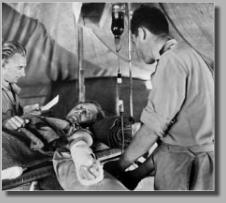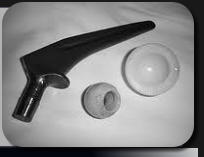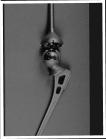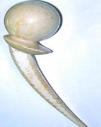


Is there a need to Expend $83 Billion on Prosthesis surgery?
In the
Journal of Arthritis
Dr. J. Cabrera gives insight into why the
costs associated with Joint prosthesis surgery are unnecessary and reveals innovative
solutions which showcase the way forward…

Historical Moments:






®
Present Day















Hip replacement surgery is in no doubt one of the most important orthopaedic
breakthroughs over the last 60 years and has has eased suffering and disability
worldwide.
After more than 60 years since its implantation, the time is now to create modern
biotechnology to resurface defects in joints, similar to what dentists have done
with tooth cavities.
Hip replacement surgery from as early as the 17th century has been
experimental with the use of materials such as celluloid, silver plates, rubber
struts, magnesium, zinc, glass, pyres, de calcified bones, wax, muscle tissue
celluloid and other failed materials.
Unfortunately no long term success stories have been recognised whilst
experimenting with these materials as patients biological systems reacted
against them. These materials were also unable to cope with the stresses
of supporting body weight for long periods. The early experimental days did
however pave a way for surgeons who endured to perfect hip replacement
surgery. Primitive surgeries were carried out to replace joints and were
plagued with a high risk of infection, which was inherent before the wide
advent of antibiotics..
Artificial hips gradually gained notoriety and an interest in medical and public
knowledge, though it was rare for someone to undergo full hip replacement
surgery.
Experimental attempts to replace joints with Teflon seemed like a good idea at
the time, but the Teflon wore out within two to three years and eventually
patients suffered osteolysis; as the bone started to dissolve and then re-
absorbed by the body. Though historical hip replacement surgery appears to
be rudimentary, it was considered a better alternative compared to the crippling
pain endured by arthritis.
Another problem with these experimental materials was that the articulating
surfaces inserted between joints were unable to be lubricated by a patients
body, which created wear and tear, thus making it necessary to replace joints
with revision surgery.
Artificial joints were eventually manufactured from steel and chrome which had
a better ‘surface life’ due to
superior strength and being non corrosive.
Dr McKee
By the early 1950s, DR. McKee, a British orthopaedic surgeon, had designed prosthesis on
the femoral side that articulated with a three claw type cup that screwed into the acetabulum
(the surface of the joint that the ball joint fits into). The initial high incidences of failure resulted
from the loosening of components as there was no adequate holding cement available to
keep the prosthesis in place for long periods of time.
It was throughout the 1960s that Hip replacement surgery became more widespread and
available to patients. At the XIX World Congress of Surgery/International College of Surgeons
(1974) Dr. McKee presented results from the first 300 total hip prosthesis and concluded that
the most important principle was to obtain the firm fixation of components in the bone using
screws, then later using acrylic cement.
Dr. San Baw
In 1960 a Burmese orthopaedic surgeon, Dr. San Baw who was chief of the orthopaedic
surgery unit at the Mandalay General Hospital in Burma pioneered the use of ivory hip
prostheses to replace united fractures of the neck of the femur.
Dr. San Baw at first bravely used an ivory prosthesis to replace the fractured hip bone of an 83
year old Burmese Buddhist nun. He continued his work up until the 1980s’ with considerable
success and is now famous for it.
Dr. Peter Ring
Dr. Peter Ring, from Surrey, England began practising with cement-less components and
utilising metal-on-metal articulation since 1964.
Dr. Rings early Arthroplasty surgery provided surprisingly good results with up to 97% of
implants remaining more than previously used materials.
Sir John Charnley
The modern artificial joint owes much to the work of Professor John Charnley from Manchester Royal
Infirmary.Dr. Charnleys’ work throughout the 1970s’ in the field of tribology resulted in a design that completely
replaced previous designs. Charnley's design consisted of three parts which included a
stainless steel metal femoral component (the ball attached to the femur) connected to an
Ultra high molecular weight polyethylene acetabular component. Both of these prosthesis
were fixed to the bone using the third and last element; a specially manufactured bone
cement. The replacement joint was known as the Low Friction Arthroplasty and was
lubricated with synovial fluid. The small femoral head on occasion produced wear and tear
problems which made it suitable only for much older patients with less mobility, however
there was a huge reduction in resulting friction which led to excellent clinical results. For over
two decades, the ‘Charnley Low Friction Arthroplasty’ design was the most used system in
the world, surpassing other available options created by McKee and Ring.
From the years of extensive training whilst working in the UK, Dr. Javier M.
Cabrera Contreras performed the worlds first recorded cemented total hip
prosthesis implant surgery within a private clinic. At the time this was big news
so it was widely reported by journalists, radio stations and television stations all
throughout South America.
Members from the International College of Surgeons XIX, (Sept 1974) which
consisted of the worlds most renowned orthopaedic surgeons were
subsequently informed of Dr. Cabreras achievements and the notoriety he
gained throughout South America for introducing a much needed change. From
this time forward, the FDA approved and granted the use of acrylic cement for
prosthesis surgery world-wide.
Throughout the last decade, developments have been created in the hope of total hip replacement procedures.
A
vast
majority
of
older
implants
are
made
of
a
ceramic
material
rather
than
polyethylene,
which
some
research
indicates
dramatically
reduces
joint
wear.
Metal-on-metal
implants
are
also
gaining
popularity
in
investigated
and
proven
negative
ways.
Orthopaedic
manufacturers
have
now
abstained
from
this
type
of
hip
prosthesis
due
to
complications
these
prosthesis
have
created,
such
as
metal
corrosion
and
the
infiltration
of
metal
particles
within
the body, and ultimately the brain.
Most implants are now fixed without cement and the prosthesis has a porous texture into which newly formed
bone grows into. This method however still proves to be too invasive.
Hip resurfacing is generally used as the alternative to total hip replacement
and is often suggested for active patients under the age of 55.
Hip replacement surgery was adapted in the 1970s’ and came with some
success, but surgeons preferred to opt for hip replacement surgery because
of early complications that resurfacing surgery created. Improvements over
the last two decades have made hip resurfacing surgery more attractive and
is has become a better option for patients, especially younger, more active
people.
Hip resurfacing surgery is vastly different from hip replacement surgery as
the femur head is reshaped, then resurfaced with a metallic shell. A metal
socket is then inserted into the pelvis to support the newly resurfaced femur
joint. This surgical procedure reduces pain and ensures better joint stability.
The chance of dislocation also lowers if resurfacing surgery is performed
rather than with a total hip replacement. Revision surgery from resurfacing is
not as complicated, due to less healthy bone removal.













The process of
manufacturing
prosthesis parts
requires large
amounts of energy
which add onto
more unwanted
environmental
pollution.













1950s
Dr. McKee designs a
prosthesis on the
femoral side that
articulates with a three
claw cup that screwed
into the acetabulum.
1960
Dr. San Baw at the
Mandalay General
Hospital in Burma
pioneers the use of
ivory hip prostheses to
replace united fractures
of the neck of the femur.
1964
Dr. Peter Ring starts a
clinical trial with
cement- less
components with a
metal-on-metal
articulation. 97% of
implants survived the
years of follow up.
1970s
Sir John Charnley
replaces previous
designs prior to the
1970s. Charnley's
design consisted of
three parts which
connected to an Ultra
high molecular weight
polyethylene ace
tabular component.
New York
A team of 35 International bio scientists,
manufacturers and doctors hold a summit
on arthritis.
Among other conclusions they discuss the
Inadequacy of arthritic classification and a
need for new treatments for the symptoms
of bone cartilage and joint structural
abnormalities in the stages of the disease.
Concerns in the scientific world about the
treatment for Arthrosis and economical
consequences of Arthroplasty surgery with
its environmental issues are raised.




Increasing Costs
In the US alone, 332,000 total
hip implants were performed.
Similar surgical procedures on
damaged joints were performed
in greater numbers, including
knees, shoulders and elbows
being the most common in need
of repair.
Dr. Javier M. Cabrera L.M.S. F.I.C.S.
Information on
Osteoarthrosis and
how the Bio Hip
can help rid the
world from Arthritic
pain.

Hip replacement
Surgery and its
countless
problems and
risks.
With over 35 years experience
in orthopaedic/spinal surgery,
Dr. Javier Cabrera patents the
Bio Total Hip

Hip Resurfacing Surgery
Modern Day Prosthesis Surgery
Worlds’ first Cemented Total Hip Prosthesis implant surgery
performed within a private clinic :September 1972/ Lima, Peru.
Dr. Javier Cabrera
The innovative design
and technology
creating a brighter
future for Hip Surgery.
History in the making…
Orthopaedic surgery owes a great deal
of its development to its role in military
conflicts throughout history.